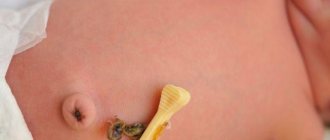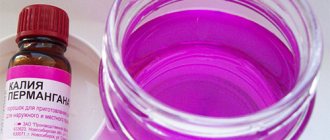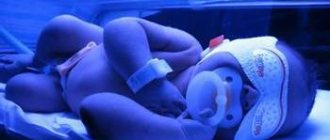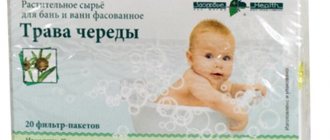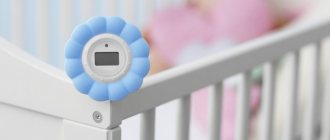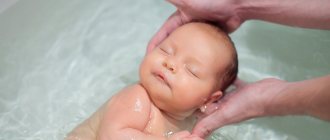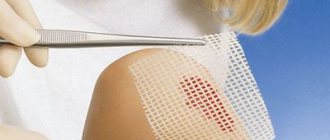In the first days/weeks of life, a newborn is very vulnerable to infections that can enter through the umbilical cord.
In such cases, you need to properly treat the baby’s navel with an antiseptic. You can use hydrogen peroxide for this. For young parents, caring for a baby is an extremely important period, and it is the umbilical cord that requires special attention. The baby's navel is a wound, and through unhealed tissue, a pathogenic infection can easily enter the child's body.
How can you treat your navel?
The most dangerous pathologies for a newborn due to improper care of the navel are staphylococcus, sepsis (blood poisoning) and omphalitis. It is extremely difficult to deal with such complications. In order for the baby to have good health, it is necessary to organize proper wound care. Among the most common antiseptic and disinfectants for treating the navel are:
- 3% hydrogen peroxide;
- brilliant green (zelyonka);
- potassium permanganate (potassium permanganate);
- chlorophyllipt.
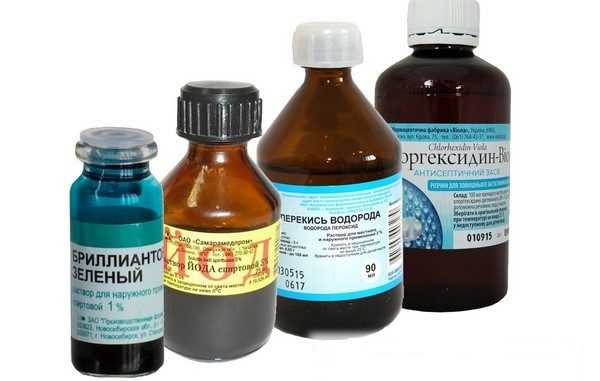
It should be noted that these drugs are a powerful antiseptic, so they must be used strictly as directed, taking precautions, otherwise the child may suffer a skin burn or purulent ulcers in the navel area.
Treatment of the navel with peroxide solution
When the baby is born, the umbilical cord is clamped closer to the tummy with a special clamp (clothespin) and cut off, leaving a small stump (tail-knot). From birth until the moment of mummification of this piece of umbilical cord, approximately 4-5 days pass, after which an umbilical wound is formed, which is a cause for concern. But with proper treatment, it heals after 2-4 weeks.
When treating a newborn's navel at home, it is important for parents to follow the rules of personal hygiene, because... there is a risk of a pathogenic infection entering the wound. To prevent infection, you should handle your baby with clean hands.
Treatment of a baby's navel with hydrogen peroxide is required for the following reasons:
- destroys harmful bacteria, infections, viruses and other pathogenic microorganisms;
- prevents inflammation;
- promotes drying and rapid healing;
- neutralizes the secretion of ichor;
- softens the crusts.
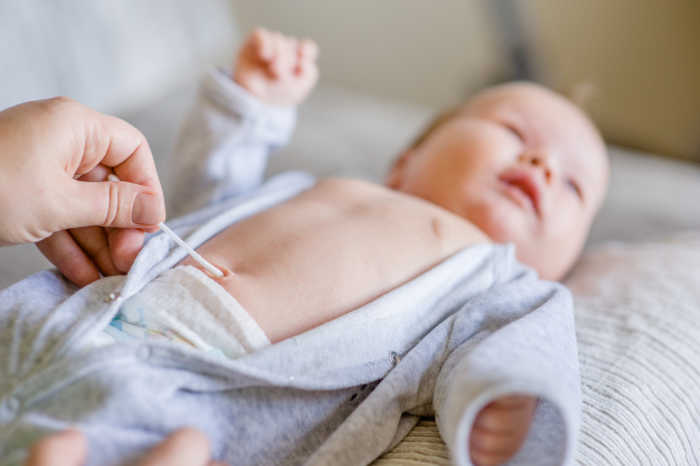
To clean the baby's navel, use cotton swabs, cotton pads, bandage swabs, and a sterile pipette. It is worth understanding that pathogenic bacteria can accumulate under the crusts, which will lead to infection and inflammation of the umbilical cord wound. Therefore, ignoring the antibacterial drug is dangerous for the baby’s health.
Treatment of the navel until the “tail” falls off
The remainder of the umbilical cord with a clothespin should be processed as follows:
- In the morning and evening, drop 1-2 drops of 3% peroxide into the navel with a pipette, be sure to wipe around its borders with a cotton pad.
- Gently move the umbilical ring with your fingers so that the antiseptic gets into the internal folds and washes out all the discharge.
- Wait until the peroxide stops fizzing (20-30 seconds).
- Remove softened crusts from around the umbilical cord.
- After cleaning the umbilical ring, the area under the clothespin is lubricated with an antibacterial agent (brilliant or chlorophyllipt).
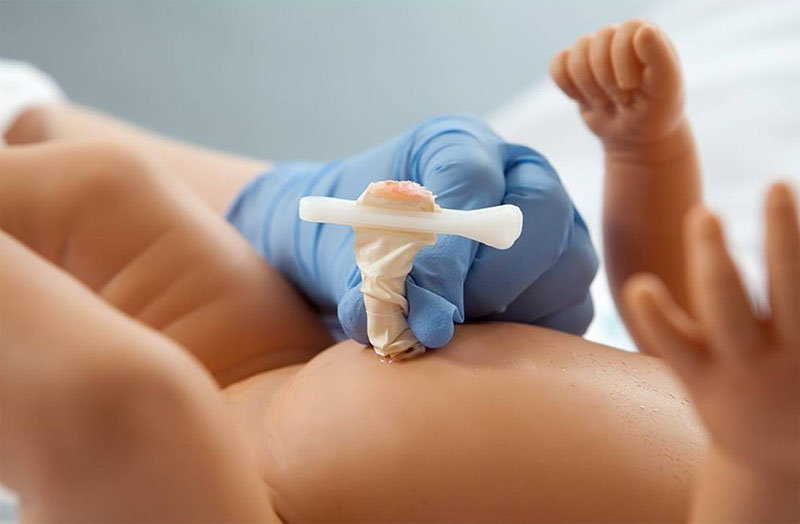
There is no need to be afraid to touch the clamp during the procedure - the main thing is not to pull or rotate it to the sides. At a certain point, the stump with the bracket will easily fall off on its own and the baby will not even feel any discomfort.
Treatment of the navel after the stump falls off
It is recommended to care for the umbilical cord wound after the remainder of the umbilical cord falls off in the morning after waking up and feeding, and in the evening after bathing, when the baby is in a calm mood. As a rule, treating the navel with hydrogen peroxide includes several successive steps:
- Wash your hands with antibacterial soap.
- Use your fingers to open the navel and drop a solution of 3% hydrogen peroxide from the pipette. It is worth considering that the peroxide solution should not be cold - before instillation, hold the pipette with liquid in your hand for a couple of minutes.
- Wait until foaming stops.
- The softened crusts are separated from the wound with a cotton swab.
- Next, dry the baby's navel well, dabbing it with cotton pads or a swab made from a bandage folded several times.
- Spread the edges of the navel again and apply hydrogen peroxide again with a cotton swab.
After the procedure, you should absolutely not cover the umbilical wound with a bandage, as this will lead to accumulation of moisture and can cause inflammation.
Rules for processing the umbilical cord in a child
Important!
If after 4 weeks of treatment the wound has not healed, although care was carried out correctly, it is recommended to contact your pediatrician. If the skin around the navel becomes red, swelling or purulent discharge appears, consult a doctor immediately!
How to treat a newborn's navel with a clothespin with chlorhexidine
In the maternity hospital, immediately after birth, neonatologists place a special clothespin on the navel of a newborn. The device stops all processes in the cut umbilical cord.
There are many vessels and other channels through which the child’s metabolic processes with the placenta took place.
What parents should pay attention to:
- The color of the tissue around the umbilical ring.
- Smell.
- Contact of clothespin with clothes and diaper.
The clothespin is removed in the maternity hospital, so parents do not need to have special knowledge on this issue.
The cutout on the diapers prevents the clothespin from catching on the edges of the diaper, creating discomfort for the child and causing pain.
If a newborn’s belly button bleeds, what should you do?
The birth is over, and a child appears in the family. Doctors cut the umbilical cord connecting him to his mother and clamp it with a special clothespin.
Nowadays in modern hospitals the navel is rarely tied. The need arises only in those clinics where the necessary materials are not available. Or in emergency conditions of childbirth.
The navel bleeds in the following cases:
- The umbilical cord is not compressed tightly enough in the case of a clothespin.
- Infection in the umbilical wound.
- Residual traces of activity.
- A disease that needs to be treated.
- Pathology. There is a need for surgical intervention.
Another option is to dilute potassium permanganate. The solution should be very cool. The color becomes saturated.
Doctors do not recommend this method for babies. The baby's skin is still very delicate and thin. There is a high risk of chemical burns.
The navel of a newborn is an open wound. After the first days after birth, children are not washed precisely for this reason. Magnesium permanganate is dissolved in water to make it safe to get wet when swimming.
The navel gets wet: reasons and advice from Komarovsky
Dr. Komarovsky says that babies' navels get wet up to three weeks - and this is normal. When ichor oozes from the wound, it must be treated with hydrogen peroxide or chlorhexidine.
To do this, apply peroxide to a cotton pad or soak a tampon in it. Apply to the sore spot for a few seconds.
After the procedure, they are treated with brilliant green. Komarovsky recommends dripping brilliant green from a pipette into the umbilical cavity and smearing it around.
Komarovsky's advice:
- When choosing between peroxide and chlorhexidine, give preference to the latter. Chlorhexidine is more recommended for open wounds with ichor.
- If the wound smells, you can use furacilin alcohol to wash it.
- Use baneocin ointment or powder instead of brilliant green. The drug successfully fights harmful bacteria and prevents infections from entering the wound.
- In the first weeks after discharge from the maternity hospital, bathe the baby in a weak solution of potassium permanganate.
- The child is placed on his back.
- A diaper is placed under the baby.
- Chlorhexidine or peroxide is dripped into the umbilical wound.
- Blot excess liquid with a cotton pad.
- An antibiotic ointment is placed in the navel and a bandage is applied.
By treating the wound with chlorophyllipt, its healing time is reduced. Chlorophyllipt contains an extract from eucalyptus leaves. It has a healing and disinfecting effect
What to do if after a month the navel continues to bleed? It is necessary to call your local pediatrician to determine the exact cause of the problem. The doctor will help you figure out how to treat the navel correctly.
How long does it take for a belly button to heal when it falls off?
All children are different. Therefore, how long the umbilical wound heals depends on a number of factors: hygienic conditions in the hospital and at home, the characteristics of the baby, the degree of correct treatment of the wound.
Doctors give parents clear instructions on how and when to treat the umbilical wound in order to avoid serious consequences.
For treatment use brilliant green, potassium permanganate, furatsilin, streptocide, ointments, chlorophyllipt, hydrogen peroxide, chlorhexidine.
For convenience, mothers often use special diapers with a cutout to avoid frequent contact with the wound:
| Name | Price | Peculiarities |
| Merries | From 415.00 rubles for 24 pieces 17 rubles per piece | The best option when choosing between price and quality. Reasonable price with decent quality product. Allergies to this type of product are rare. Diapers absorb well |
| Molfix | 539.00 rubles 44 pieces 12 rubles per piece | An affordable option for most parents. Such production complies with the necessary criteria for all parameters. But the quality leaves much to be desired |
| Goo.n | 1,487.00 rubles for 60 pieces 25 rubles per piece | One of the most expensive diapers. High technological developments have made it possible to create an absorbent layer of the best quality. Causes minimal allergic reactions |
| Libero | 315.00 rubles for 24 pieces 13 rubles per piece | One of the cheapest diapers. They perform their absorbent function. The baby's skin remains moist. Interesting design |
It doesn’t matter on what day the belly button falls off, it is important that the child is healthy. The navel always falls off while still in the maternity hospital, where the stay usually takes no more than a week.
Therefore, mothers do not have to worry about this issue. If there are no healing dynamics in the second week, you should seek help.
When the navel falls off, doctors remove the clamp and treat the wound themselves. During this period, parents receive the most comprehensive instructions on what to do next.
The navel of a newborn is festering: how to treat it at home?
Young parents may notice inflammation of the umbilical cavity while bathing their baby. The navel is red and looks unhealthy. There is something sticking out in the navel, but it doesn’t stick out at first. After a few days it increases in size.
This disease is called fungus or granuloma. Proliferation of granulomatous tissue for unknown reasons. A common disease in infants. The treatment is simple.
After removing the granuloma, the navel is treated with brilliant green, peroxide, and washed with clean boiled water or chlorhexidine.
The technique is as follows:
This disease causes panic among parents. There is no reason to worry. It is necessary to follow the rules for disinfecting the umbilical ring.
Hernia is common in babies. The hernia is especially noticeable when crying. As the abdominal muscles strengthen, the hernia may disappear. Otherwise, a sectioning operation is necessary.
Good afternoon, dear readers! This is not the first time I have heard that doctors prescribe chlorhexidine after discharge from the hospital. This is new for many parents. After all, for the most part, brilliant green or other antiseptics are recommended.
Therefore, such appointments frighten young mothers. Is it possible to treat a newborn's navel with chlorhexidine? Today I will try to answer this question, based on the recommendations of the Ministry of Health.
Harm or benefit?
In order not to scare you right away, I will say that any substance has not entirely useful properties. Yes, you yourself know very well about this. But this antiseptic has a bad reputation, most likely due to the carelessness of you and me. Did you know that the solution comes in several concentrations? Yes, 0.05, 0.2 and 0.5%.
Therefore, before you get scared, look at what concentration the pediatrician prescribed. If this is not indicated in the list of recommendations, please clarify. Newborns are usually prescribed a 0.05% solution. This is not too strong a concentration. Let's just say it's a completely acceptable form.
Just on forums and in life, this remedy is considered one of the thermonuclear antiseptics. But in fact, its strength depends only on concentration. This substance perfectly protects against infection. Those who have tried 0.5%, of course, will claim incredible power and will never use this drug for babies. And those who carefully study the instructions will do the opposite.
From this I conclude that chlorhexidine can be used to treat the navel of babies. You just need to read the labels and specialist recommendations.
How to properly treat an umbilical wound?
When our daughter was born, we treated it as the pediatrician said: peroxide and brilliant green. I got acquainted with chlorhexidine for a different reason. One day my throat hurt so much that I became hoarse. The infection spread instantly! I just didn’t know what to do. The pills didn't help.
Then the pharmacist advised me to try inexpensive but high-quality chlorhexidine. I had a hard time believing that this would help. But I was wrong. The drug helped! Since then, it has always been in my medicine cabinet.
And recently I learned that in 2013, WHO added chlorhexidine solution to the list of vital drugs. And recommended for use by children! More precisely, for infants to treat the umbilical cord.
After all, this way it begins to heal faster and the risk of infection is minimal!
So how can they process them correctly?
At the first stage, of course, I wash my hands.
We drip peroxide onto the wound.
We wait until it sizzles, remove the crusts that come off easily.
Now we blot dry. Before treating with an antiseptic, the navel must be dry.
Pour chlorhexidine into the wound.
Carry out this procedure 1 - 2 times a day. A larger number of treatments is permissible for non-healing and problematic wounds. The doctor will tell you here.
Contraindications
Fortunately, there are few of them. But they are:
Hypersensitivity to the components of the drug.
With caution: children's age.
It is not recommended to use for dermatitis.
Confused by children's age? But this is not a direct contraindication. You just have to be careful here. After all, the drug is not without side effects.
Side effects
External use may cause a negative skin reaction. Based on reviews, I won’t say that this happens often, but still. For example, green grass is not so aggressive and I have not heard of it ever causing allergies. But brilliant green is also inferior in effectiveness to chlorhexidine.
However, if after use you notice a rash, itching, or redness in your child, stop taking the drug. Be sure to show the baby to the doctor so that he can give further recommendations and tell you how and how to care for the umbilical wound.
Now I’ll be interested to hear how and what you use to treat your baby’s navel? How quickly does healing occur? What does the doctor recommend? Have you tried chlorhexidine? Leave comments on the topic. And become new blog subscribers. Until next time. Bye!
Source: https://rody-beremennost.ru/voprosy/kak-obrabatyvat-pupok-novorozhdennogo-s-prishhepkoj-hlorgeksidinom
Treatment of the navel with hydrogen peroxide and brilliant green
Of all the antibacterial baby care products, treating the navel with hydrogen peroxide and brilliant green is the most popular procedure. The navel is located close to the child’s vital organs, and if wound healing does not proceed well, dangerous complications may develop that require antibiotic therapy or hospitalization. In the first days of a newborn’s life, bloody discharge from the navel is possible, so the umbilical wound should not be allowed to become infected.
In principle, the algorithm for disinfecting a baby’s navel is the same as in the previous instructions:
- 2 times a day.
- Clean hands.
- Pipette and instillation of the navel.
- Gently clean the navel of crusts.
- Dry the wound with a cotton pad.
- Apply brilliant green with a cotton swab.
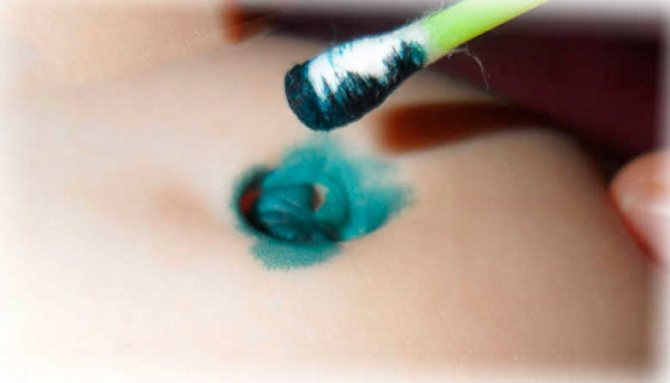
It is necessary to treat the wound directly with brilliant green (that is, there is no need to lubricate the skin around it). An important nuance: brilliant green does not need to be “smeared” in the literal sense, but applied with blotting movements from the center to the edges. Daily treatments speed up healing, since this product disinfects and dries well.
Although brilliant green is an alcohol-based antiseptic, it acts more mildly than iodine and is therefore safe for external use. The main disadvantage is the persistent staining of the skin, which is why it is often replaced with a modern drug - chlorophyllipt.
Helpful advice
Pediatricians recommend bathing newborns in water with potassium permanganate, which disinfects the water and prevents infections of the umbilical wound. To disinfect the water, just a pinch on the baby bath is enough to turn the water a little pink. After such a bath, be sure to apply post-bath lotion to the baby’s skin, because... potassium permanganate can dry out delicate skin.
What to do with the umbilical wound?
While the mother and child are in the maternity hospital, medical personnel help monitor the navel. You will need to take care of the baby yourself at home. Most often, the wound heals within 3 to 4 weeks. In order for the belly button to heal faster, you must follow certain rules:
- The wound should not be wet. It is strictly not recommended to bathe a child in a shared bath until the navel has healed; pathogenic bacteria can enter the blood through it. A weakened body is not always able to cope with them;
- It is necessary to bathe the newborn in boiled water, you can add a little manganese solution. You need to make sure that water does not get into the wound; in the first weeks of life, it is not necessary to wet the child completely; it is enough to wipe him with a wet washcloth made of soft material.
- Once a day, after bathing, it is necessary to treat the navel with drying antiseptic agents. An alcohol solution of brilliant green (brilliant green) and hydrogen peroxide are used. You can replace brilliant green with chlorophyllipt. If the navel becomes wet, it is necessary to treat the wound more often - up to 3 times a day.
- For the navel to dry out, it needs air. You need to make sure that the wound does not come into contact with tight clothing and does not rub against the diaper. You can purchase special models that have a hole for the navel, or bend the edge of regular ones.
- It is necessary to change the diaper in a timely manner so that urine does not get into the wound. If the navel still gets wet, you need to carefully wipe it with a swab and an antiseptic.
- Do not lubricate the wound with baby hygiene products - creams, oils. They help against diaper rash, but interfere with the healing of the wound, block the access of oxygen to it and promote the proliferation of microbes.
How long to treat the umbilical wound depends on the speed of healing. At first, the umbilical wound may bleed a little, but then it goes away. A month after birth, it is completely healed and cleared of crusts.
